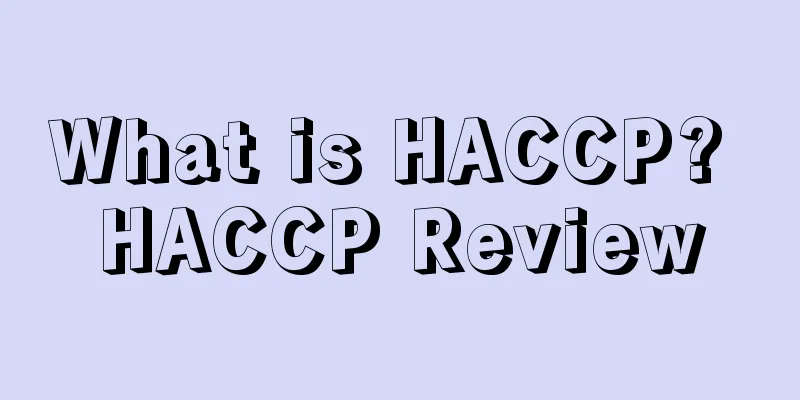What is HACCP? HACCP Review

HACCP is the abbreviation of Hazard Analysis Critical Control Point, which stands for Hazard Analysis Critical Control Point . HACCP is an internationally recognized and accepted food safety assurance system that mainly controls the microbial, chemical and physical hazards in food.reasonIt was jointly developed by Piersberg and NASA in the 1960s to provide food safety for astronauts. This certification standard is highly recognized in countries such as the United States, the United Kingdom, Australia and Canada. HACCP certification is more stringent than QS quality certification, and foods with HACCP certification are less likely to be contaminated during production. Basic meaningHA: refers to the process of collecting and evaluating information about hazards and the conditions that lead to the existence of these hazards to determine which hazards have a significant relationship to food safety and need to be taken seriously in the application of HACCP. CCP: refers to the link where control measures can be implemented on certain potential hazards (some hazards). This link can prevent and eliminate the hazard (some hazards) or reduce them to an acceptable level by taking control measures. Hazard: refers to the biological, chemical or physical factors present in food that can cause potential adverse effects on human health. Control measure: Any step or action taken to prevent and eliminate a food safety hazard or reduce it to an acceptable level. HACCP includes 7 principles1. Conduct hazard analysis; 2. Determine the critical control points; 3. Determine the critical limits of each critical control point; 4. Establish monitoring procedures for each critical control point; 5. Establish corrective actions to be taken when monitoring indicates that a critical control point is out of control; 6. Establish verification procedures to prove the effective operation of the HACCP system; 7. Establish a system of records of all applicable procedures and these principles and their application. Scope of applicationCountries that have promoted and applied HACCP well include Canada, Thailand, Vietnam, India, Australia, New Zealand, Iceland, Denmark, Brazil and other countries. Most of these countries have mandatory implementation of HACCP. The areas where the HACCP system is implemented include: drinking milk, cream, fermented milk, lactic acid bacteria beverages, cheese, ice cream, raw noodles, tofu, fish and ham, fried meat, egg products, salads, dehydrated vegetables, condiments, mayonnaise, boxed lunches, frozen shrimp, canned food, beef products, pastries, soft drinks, sausages, mechanically cut meat, salt-dried meat, frozen vegetables, honey, high-acid foods, meat and poultry, fruit juice, vegetable juice, animal feed, etc. Development HistoryThe establishment of the HACCP system began in 1959. At that time, it was mainly to meet the needs of developing space food, that is, how to ensure that the food used in space is 100% safe as much as possible. In 1971, Pillsbury first proposed the HACCP management concept at the National Conference on Food Protection. A few years later, the US FDA adopted it as the basis for the formulation of acidic and low-acid canned food regulations. After 1974, the concept of HACCP has appeared in a large number of scientific and technological literature. The United States was the first country to apply the HACCP principles and to enforce HACCP supervision and legislation in food processing and manufacturing. In October 1989, the U.S. Food Safety and Inspection Service (FSIS) issued “HACCP Principles for Food Production”; In April 1991, the "HACCP Evaluation Procedure" was proposed; The "General Rules for HACCP of Frozen Foods" was published in March 1994; In 1994, FDA published "HACCP Progress for the Food Industry" for food safety assurance measures; In December 1995, the FDA issued the regulation "Measures for the Safe and Sanitary Processing and Import of Seafood"; In April 1998, FDA announced that juice processors must implement HACCP, and then proposed a management plan including HACCP for egg production. References |
<<: What is Ecomdash? Ecomdash Review
Recommend
Walmart WFS delivery service performed strongly in 2021, up 500%!
<span data-shimo-docs="[[20,"获悉,据外媒报道,近日沃尔...
What is BSMI certification? BSMI certification evaluation
Taiwan BSMI certification "Electrical Safety ...
What is 17TRACK Logistics Express Parcel Tracking Platform? 17TRACK Logistics Express Parcel Tracking Platform Review
17TRACK is a global logistics and express parcel t...
What is Aftership? Aftership Review
Aftership is a company that connects to the global...
What is the Basic Sales Plan? Basic Sales Plan Review
The Basic Sales Plan is a new sales plan launched ...
What is the SSCC code? SSCC code review
Serial Shipping Container Code (SSCC ) is a code t...
What is the long-term storage fee? Long-term storage fee review
Amazon FBA Long-Term Storage Fees are in addition ...
How to find keywords suitable for your products
When optimizing listings, many sellers are confus...
(Operational Tips) How to do a good job of Amazon QA and boost listing traffic
When it comes to listing optimization, many selle...
What is compliance? Compliance assessment
Compliance (Compliance Troubles) refers to the con...
The secrets of the US holiday season trend are revealed! More than 70% of people will shop on e-commerce platforms!
It is learned that in order to help sellers better...
What is Amazon Review Analytics? Amazon Review Analytics Review
One of the must-do operations for Amazon sellers i...
More than 50 countries have grounded flights to the UK, paralyzed logistics! A large number of Amazon stores have been banned from selling!
The new strain of the coronavirus in the UK has ca...
What is Iconosquare? Iconosquare Review
Iconosquare is a powerful Instagram and Facebook a...
Cross-border e-commerce independent station operation——five essential elements
As an e-commerce pin Sale Those ,us all Know the ...









